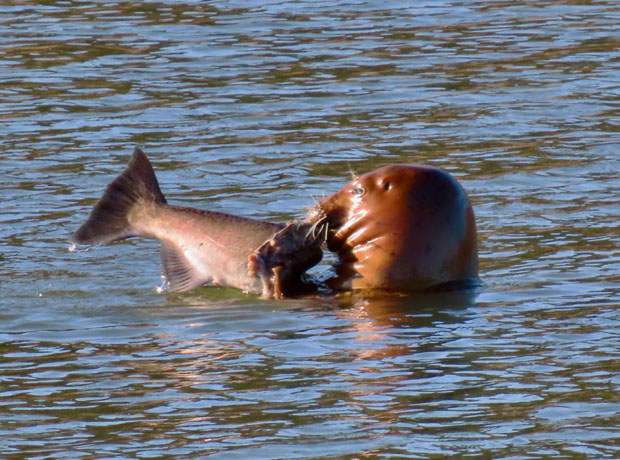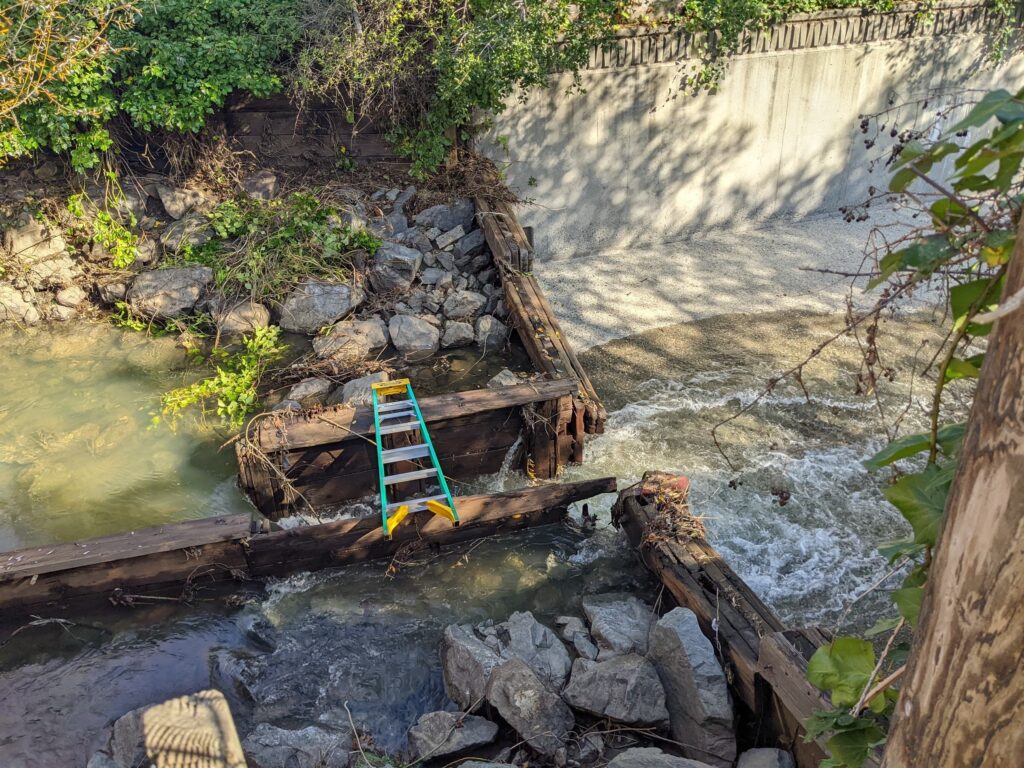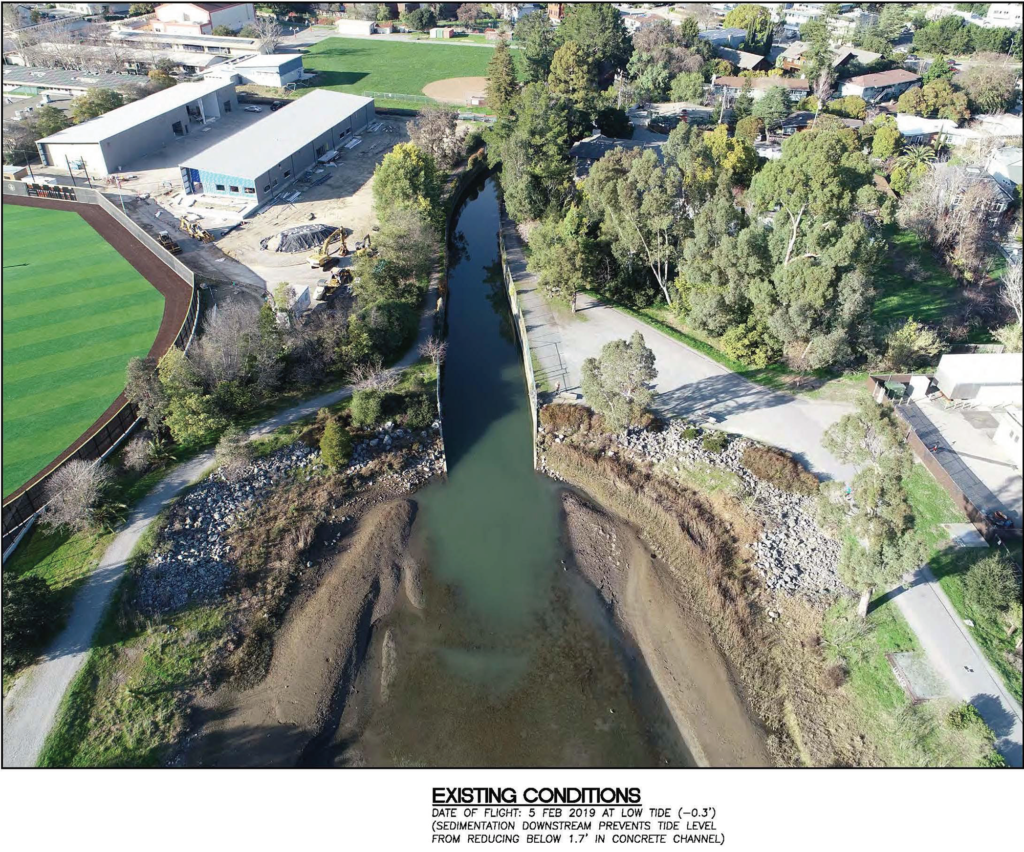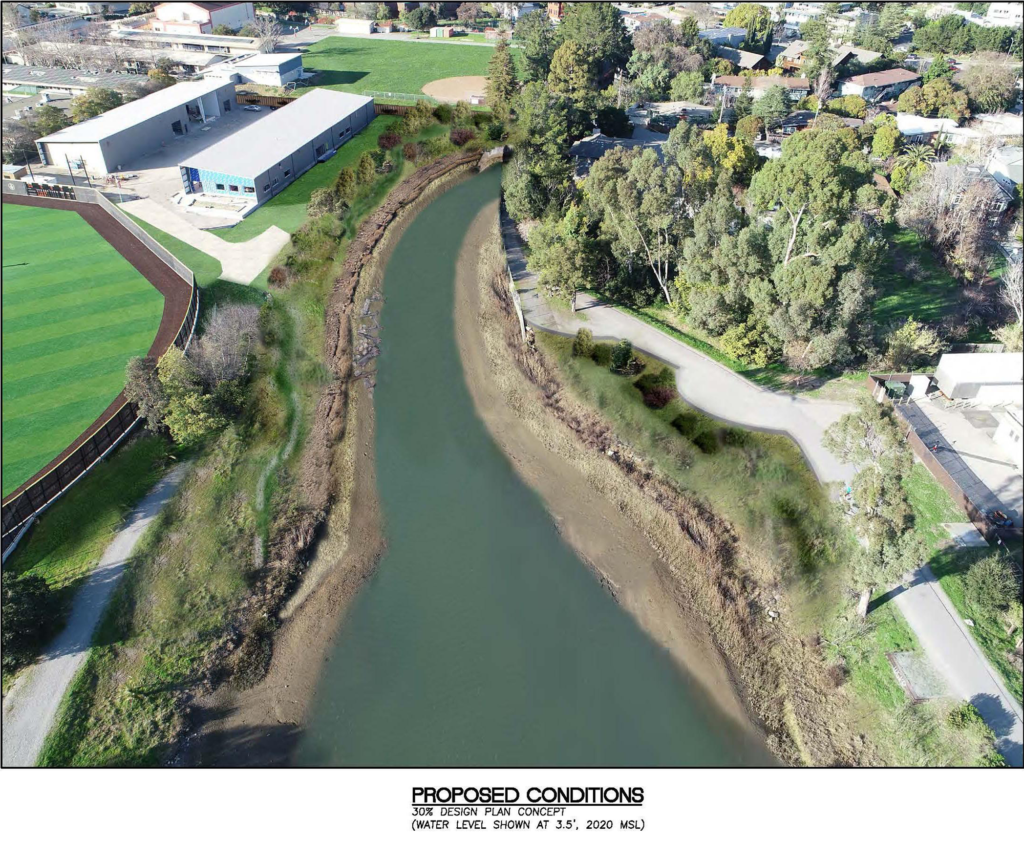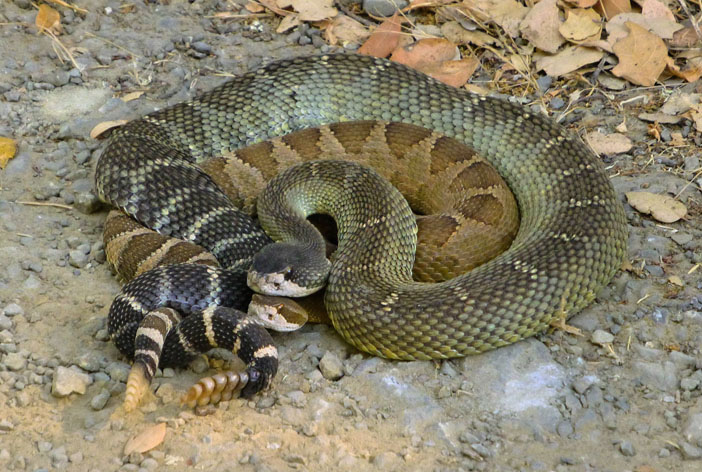Harbor Seal Meets Chinook Salmon
Salmon and steelhead are not the only animals that migrate up Corte Madera Creek when the fall and winter rains come. Robin Winning photographed this encounter in early November where Tamalpais Creek empties into Corte Madera Creek, just downstream of the concrete channel. In our watershed, Chinook are considered strays seeking the Sacramento River.
San Anselmo and Flood Control Zone 9
Many San Anselmo residents recently received a flyer promoting withdrawal of the Town of San Anselmo from Flood Zone 9 (FZ9). Although we are all disappointed at how the implementation of flood risk reduction has proceeded, the flyer is misleading in many ways.
Stormwater Fees Would Remain:
Because the San Anselmo Flood Risk Reduction Project is underway, San Anselmo residents would continue paying the fee until that project is completed or 2027, whichever comes first. Withdrawing from FZ9 would not immediately remove the stormwater fee from the property tax bills for properties in San Anselmo.
Delays and Opposition to Valid Flood Risk Reduction Measures Waste Funds:
At the start, a lawsuit claiming that the election to implement the stormwater fee was invalid caused a two-year delay. This was followed by a deceptive campaign to persuade the public to oppose detention basins in general and one in Memorial Park in particular, leading to further delays and unnecessary expenditures.
Detention Basins—Widely Used and Effective:
Detention basins are a major flood management strategy throughout California, the United States, and the world. They are not mosquito-infested bogs that promote drowning. During the vast majority of the time, they provide recreational facilities or open space for public enjoyment. San Anselmo would already have reduced flood risk if the Memorial Park project had been implemented.
Planning Saves Money:
FZ9 revenue has funded development of a detailed computer model of how creeks in the Ross Valley function, providing information crucial to implementing projects that actually reduce flood risk. In addition, it pays for environmental review and resource surveys required by law. They are not a waste of money; they serve to protect all the stakeholders in a complex undertaking. FZ9 revenue has attracted significant outside funding.
FZ9 Measures Have Reduced Flood Risk:
Although actions have been blocked in San Anselmo, FZ9 has implemented measures to benefit Fairfax, Kentfield, and Larkspur. The Sunnyside Flood Detention Basin will reduce flooding along Fairfax Creek and downtown Fairfax; a pump station protects Granton Park in Kentfield; a pump station and several storm drain projects have been implemented in Larkspur. To support effective management during storms, FZ9 provides staff to monitor six stream gages in the watershed and supports annual creek maintenance in the watershed. More projects are in the queue for construction in 2025. These include removing the wooden fish ladder in Ross and building a transition structure to the natural channel upstream; improving fish passage in the concrete channel; raising walls on one side of the concrete channel to prevent channel overflow into portions of Kentfield; and habitat restoration and widening of the channel at the downstream end of the concrete channel in Kentfield.
Building Bridge 2:
Although dubbed Creek Park Plaza, BB2 is not part of Creek Park and is not owned by the Town. The Marin County Flood Control District owns the bridge, which constricts flow in San Anselmo Creek, resulting in flooding downtown. It has been declared by engineers to be unsafe for public use. Its closure is unfortunate, but necessary.
A New Pamphlet of Local Flora and Fauna
In preparation for a Friends bioblitz held in June at Deer Park in Fairfax, Alycia Matz and colleagues compiled a beautiful guide to identifying 69 common upland species from the watershed. The guide also includes ecological information and traditional human uses for each species. You can view or download it via the link below. In October, another bioblitz was held, in Piper Park, and a pamphlet on saltmarsh flora and fauna was prepared. Both pamphlets can be found through our Watershed page.
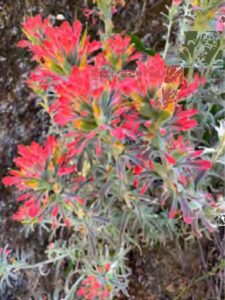
Woolly Indian Paintbrush
photo by Alycia Matz
One Across, One Down: A Help Up?
The broken wooden fish ladder behind Ross post office, long obstructing migrating fish, may be removed, after many studies of flow dynamics, property issues and environmental concerns. This is the interface that launched a thousand sheets. Photo by Matt Smeltzer
Improvements to the Concrete Channel
The State Coastal Conservancy has provided funding for two projects related to modifications of the concrete channel: one project will develop 65% designs to remove part of the concrete channel at its downstream end and the second will prepare 35% designs to modify the concrete channel to improve fish passage upstream of the Math-Science-Nursing Bridge on the College of Marin Campus.
 The Coastal Conservancy is a California state agency, established in 1976, to protect and improve natural lands and waterways, to help people get to and enjoy the outdoors, and to sustain local economies along California’s coast. It acts with others to protect and restore, and increase public access to, California’s coast, ocean, coastal watersheds, and the San Francisco Bay Area. Its vision is of a beautiful, restored, and accessible coast for current and future generations of Californians. More about the Coastal Conservancy’s program can be found at the Conservancy’s website at scc.ca.gov. Information about the Marin Community Foundation can be found at marincf.org.
The Coastal Conservancy is a California state agency, established in 1976, to protect and improve natural lands and waterways, to help people get to and enjoy the outdoors, and to sustain local economies along California’s coast. It acts with others to protect and restore, and increase public access to, California’s coast, ocean, coastal watersheds, and the San Francisco Bay Area. Its vision is of a beautiful, restored, and accessible coast for current and future generations of Californians. More about the Coastal Conservancy’s program can be found at the Conservancy’s website at scc.ca.gov. Information about the Marin Community Foundation can be found at marincf.org.
Project to Remove Lower Reaches of the Corte Madera Creek Concrete Channel
The project illustrated below would create approximately 0.6 acres of new tidal and wetland habitats and 0.8 acres of new riparian and upland transitional habitats by removing or lowering approximately 625 lineal feet of concrete flood channel wall. Importantly, the new habitats would use appropriate native vegetation and be designed at elevations that would accommodate sea-level rise so they would be resilient to climate change. The 65% designs will be prepared in Fall 2020 and used to seek construction funding.
Other notable project elements include:
- Hydraulic analysis to confirm project would not increase flood water surface elevations
- Improvements to an existing multi-use pathway and “pocket-park” adjacent to the creek
- New vegetated basins and bio-swales for stormwater run-off to replace existing storm drains that feed directly into the creek, and
- Re-use or recycling of all materials removed for the creation of the new habitats.
Improvements to Fish Passage in the Corte Madera Creek Concrete Channel
Michael Love & Associates (MLA) evaluated the use of new, larger resting pools to improve passage success within the concrete channel in 2007. The analysis identified two configurations of pools that would provide low velocity zones suitable for steelhead to rest at all fish passage flows and that would minimize sedimentation. One was better for straight reaches of the channel and the second better in curved reaches. Current efforts are responding to an additional complication: more water needs to be accommodated in the concrete channel to reduce flooding. MLA and engineers from GHD, consultants working with the Flood Control District on the project, are designing measures to meet all three objectives. The 35% designs are expected in mid-2021.
They Must be Bats!
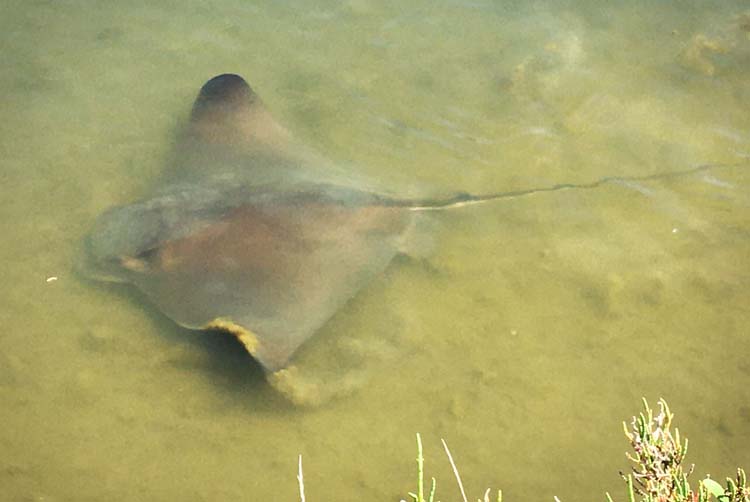 In mid-April, just after noon, two bat rays (Mylobatis californica) were spotted in the McAllister Avenue slough, a remnant of Corte Madera Creek’s original alignment, just downstream of the concrete channel in Kentfield. Every spring these rays gather in the shallow warm waters of coastal California’s bays and sloughs to feed, mate, and give birth. The creature’s wingspan can exceed five feet. Photo by Nick Salcedo
In mid-April, just after noon, two bat rays (Mylobatis californica) were spotted in the McAllister Avenue slough, a remnant of Corte Madera Creek’s original alignment, just downstream of the concrete channel in Kentfield. Every spring these rays gather in the shallow warm waters of coastal California’s bays and sloughs to feed, mate, and give birth. The creature’s wingspan can exceed five feet. Photo by Nick Salcedo
So Much Pickleweed, So Little Time
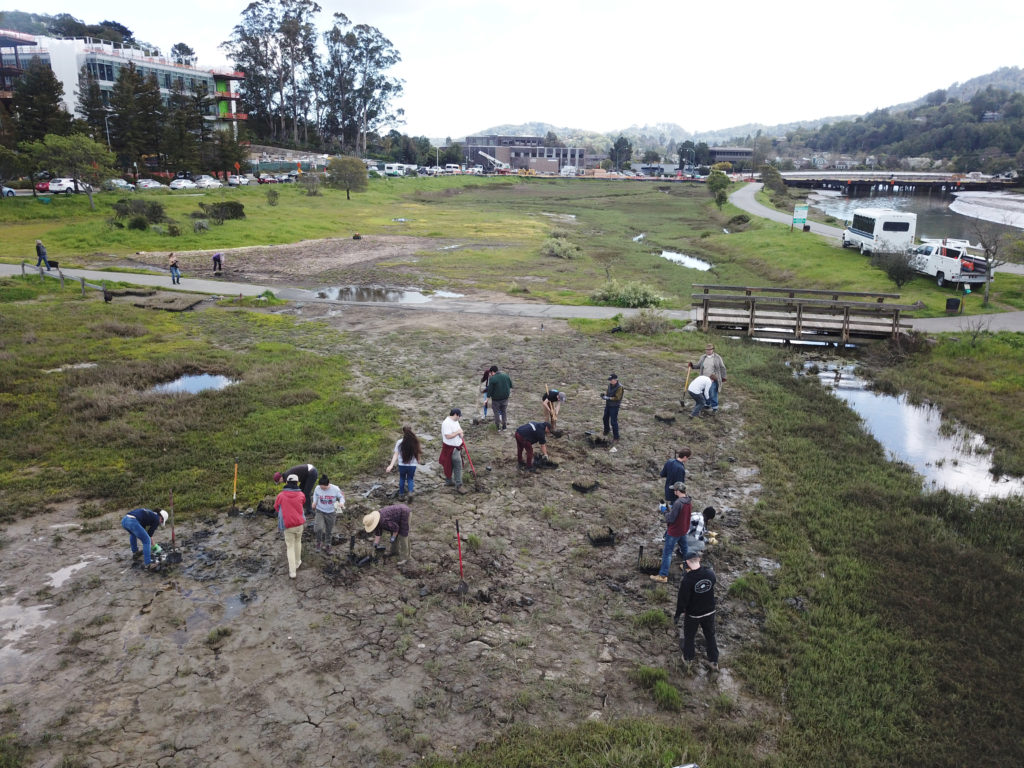
In late March, students from Professor David Larsen’s class pursuing Environmental Studies at CSU East Bay helped plant pickleweed at Creekside Marsh, one of Friends’ habitat enhancement projects. Earlier in the day, the class was given a tour of Corte Madera Creek and a sewer pump station by the Marin County Flood Control and Water Conservation District and the Ross Valley Sanitary District, a funder of the planting project. Photo courtesy of Ross Valley Sanitary District.
Snakes in Love
Otter on the Lookout

This lone river otter explored the deep pools at a bend in San Anselmo Creek in Fairfax for about half-an-hour before deciding to go and see what lies beyond the watercress upstream. Photo by Gary Leo. Local otter sightings can being recorded at riverotterecology.org. To view a video by Gary, download: River Otter 6 1.4M

